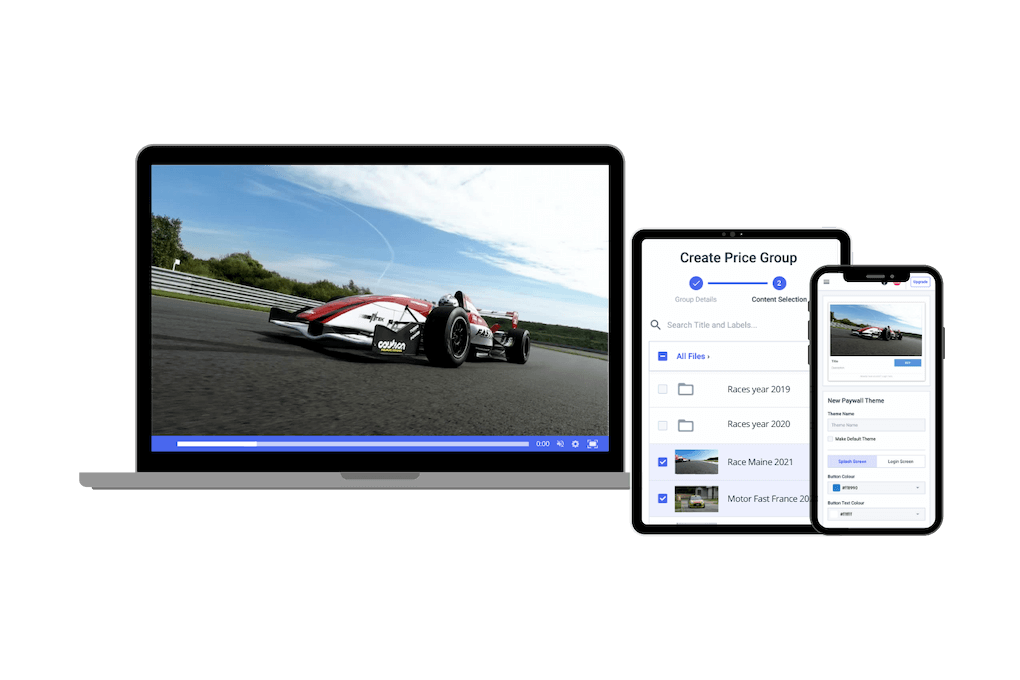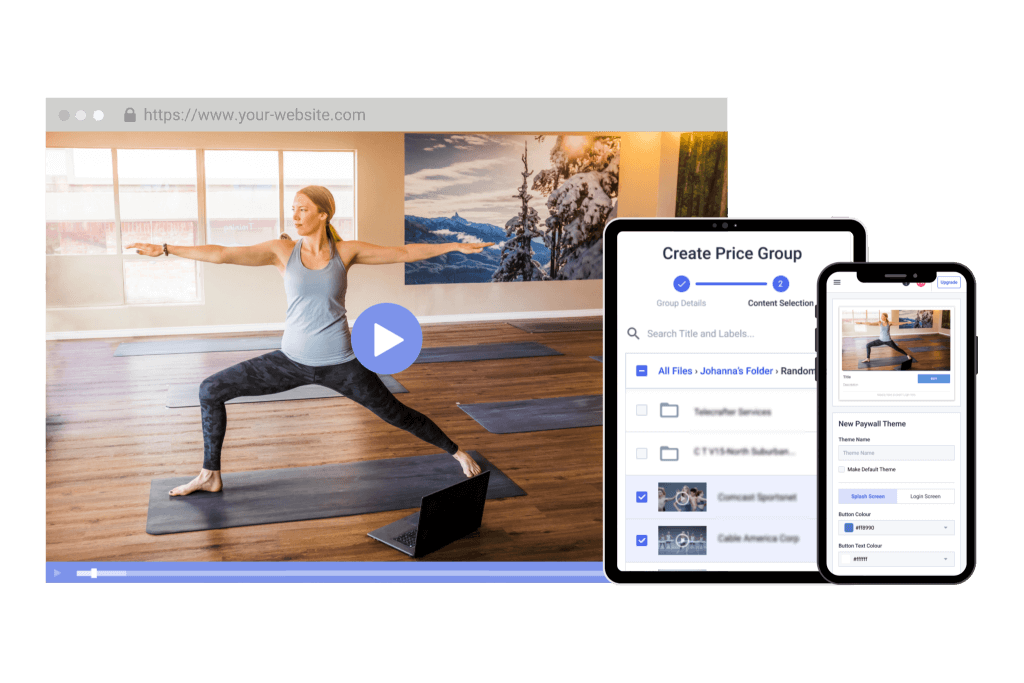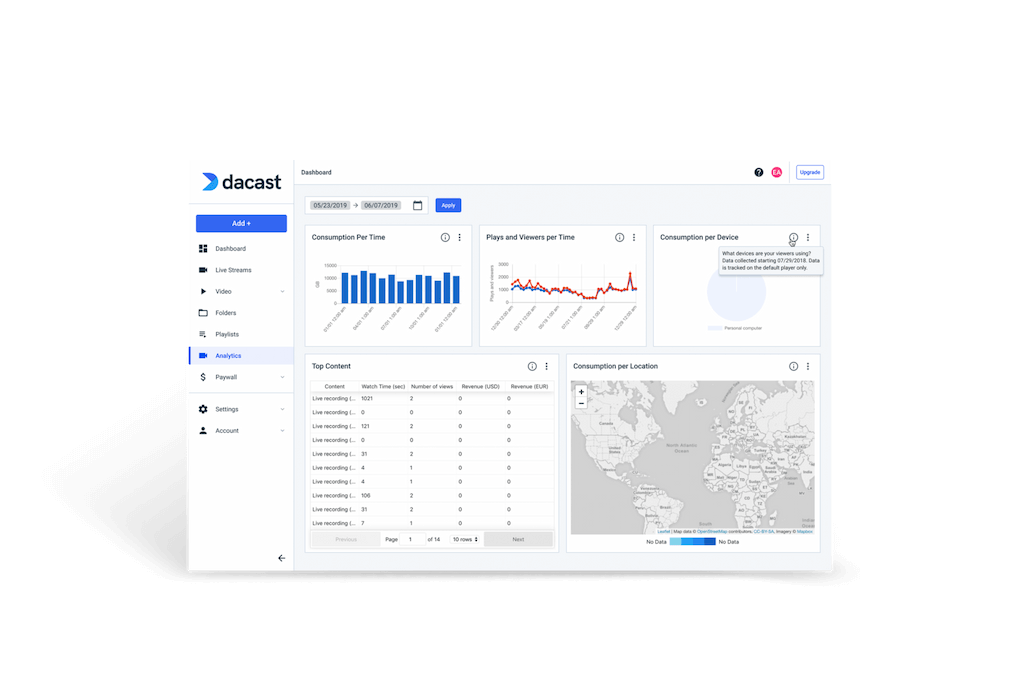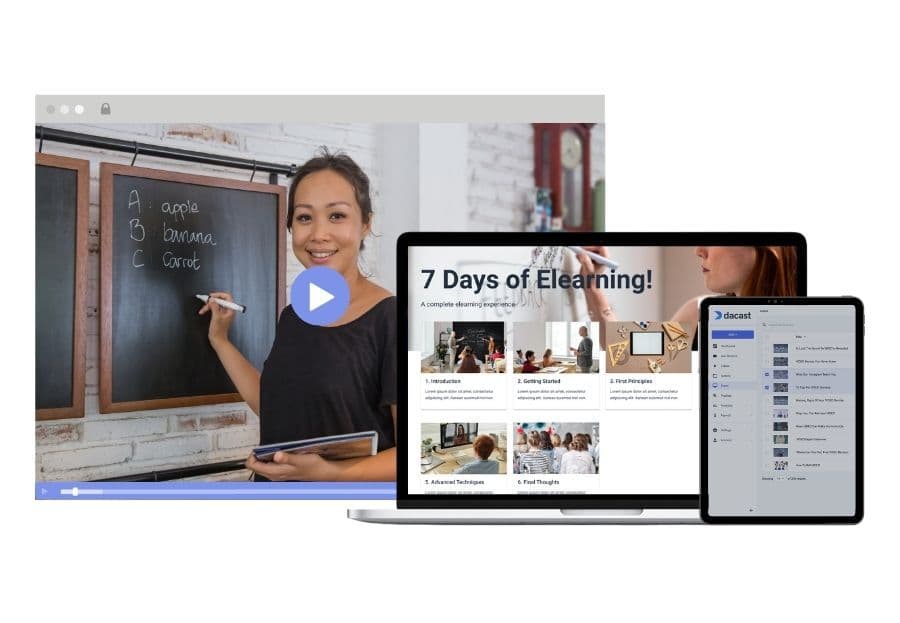How Much Does It Cost to Start an OTT Platform in 2024?
Content streaming services and online video content live streaming continue to grow. As more people have streaming access and live stream their favourite content, businesses are looking for ways to increase their leverage. One method of doing this is by developing their own over-the-top (OTT) platform. With OTT platforms, they can distribute and monetize their content more effectively.
We cover how creating your own OTT platform can benefit your broadcasting and streaming. Also, we discuss and define OTT channels and the factors that impact how much creating an OTT channel costs. Finally, we go through the models you can use to monetize your video content.
Table of Contents
- What is an OTT Platform?
- 9 Factors Impacting OTT Channel Costs
- Ways to Monetize OTT Technology
- FAQ
- Conclusion
What is an OTT Platform?
An over-the-top, or OTT, platform is a media service that’s offered directly to users through the internet.
Rather than utilizing traditional channels, such as cable, broadcast, or satellite television, to distribute streaming content, OTT channels send their videos directly to consumers over the internet. This service model allows the companies that run the OTT platform to control the content and how it’s distributed, as well as any ways that money will be made from that content.
Why Create an OTT Platform?


The internet is full of OTT streaming services, including giants such as Netflix, Amazon Prime, and YouTube.
As a content creator, you certainly can utilize these channels to distribute your content. However, many businesses don’t want the limits placed upon them when using someone else’s OTT streaming technology.
Some reasons businesses and creators build their own OTT platforms include:
- Not wanting someone else to own their content and how it’s distributed
- Wanting to have flexible OTT monetization methods
- Need to white-label the video player for use on their website
- Want to control how their content is distributed
Whatever these reasons may be, the choice to build an OTT platform doesn’t come without its significant costs of services.
9 Factors Impacting OTT Channel Costs
Several factors impact over-the-top channel costs. Here are 9 major factors that go into how much it will cost to develop an OTT platform:
Design, Testing, and Optimization
When many people think of creating their own OTT streaming service, paying someone to design the platform is the main thing on their minds.
And while the costs to design and develop a platform can be high, especially if you’re paying for a top-tier professional developer, there’s more to launching the streaming service than just design. Your OTT platform has to be tested to work out any bugs, and optimized so it works well on a variety of different devices and at different internet speeds.
This process can take quite a while, sometimes a year or more depending on complexity, with the costs ticking up daily.
Regulations and Requirements
Once your platform is launched, it requires frequent updates and maintenance so it remains accessible and in great working condition for your users.
This requires someone dedicated to keeping track of any needed updates and maintenance, as well as any changing requirements from places such as an app store where you’ve listed your software for download. If you don’t comply with every requirement of your chosen app store, you have to go back to the drawing board with your technology, further delaying your widespread launch.
Balancing user-friendliness, high-quality streaming, and top-of-the-line technology can be a struggle your streaming service must overcome.
Flexible Monetization Methods


You create valuable, helpful content and deserve to get paid for all the time and talent that goes into creating that content.
To do this, your OTT technology needs to incorporate some sort of monetization option. And, if you want to be able to make money in different ways from different videos, you need to include more than one monetization method.
Being able to offer a subscription channel for most of your content, for example, but then upsell current customers to an exclusive pay-per-view video gives you more potential income sources and diversifies the services you offer.
But there’s more to monetizing your content than just choosing a method by which you’ll get paid; you need to have a smooth way for users to pay for your video streaming service.
This requires integrating in-app payments and building your OTT streaming platform around an existing payment processor. Depending on the payment system you use, this task can be tricky and frustrating for a developer and opens your platform up to consistent bugs if your payment system and OTT platform don’t work well together.
Localization and Language
If you’re looking to expand your content’s reach to a variety of countries, you’ll need to factor in the need to localize the customer experience into your development plans.
Different countries have different streaming requirements and may require additional customer support personnel who speak multiple languages.
This increases your OTT streaming service’s cost exponentially, depending on how many countries and languages you need to factor into your strategy.
Your streaming platform and content need to not just be accessible in a variety of countries but also perform well on devices available in those countries. Multiple language options for content subtitles and in-app copy also are necessary, and you should have customer support personnel who can capably speak to customers in a variety of languages.
Great Customer Support
While you certainly want to aim for your OTT platform to be as bug-free and user-friendly as possible, that just isn’t a reality. Because of this, you need to include a great customer service department or solution in your budgeting plans.
The customer experience you provide is going to be a big contributing factor that goes into your platform’s success rate. If people don’t get their problems handled and questions answered promptly by someone friendly, they’ll be less likely to stick with your platform.
Whether you outsource your customer service to a third-party service or you hire representatives in-house, anyone answering the phones for you needs to be trained and supported to provide the level of customer service you want to offer.
Easy-to-Use Content Management
Your platform needs to be intuitive for both video viewers and your team members. This requires a streamlined, well-designed content management system (CMS).
A great CMS should make it easy for anyone – trained or not – to upload and organize videos, including the ability to tag and sort them into categories for easy reference. If you design a CMS that’s clunky and practically requires a physics degree to operate, your team will grow frustrated trying to upload and share content to your streaming service.
Some key features to include in your platform include:
- Batch editing or deleting of videos
- Support for adding a custom thumbnail
- Ability to group videos, such as in a playlist
- Bulk uploading
- Ability to embed a video anywhere
- Capability to replace a video without changing the URL or updating embed codes
These features make uploading and sharing content quick and easy and put your whole team on the same page in executing your video streaming strategy.
Ongoing Maintenance
Launching your own OTT streaming service is much more than just the initial development; a large portion of your OTT channel costs comes in the form of ongoing maintenance and updates to keep things running well.
And, if you hope to stay ahead of the curve in regards to streaming service technology, you’ll need to continually update and innovate so your OTT platform stands out.
This portion of your OTT channel pricing can get expensive, as you may have to pay for pricey freelancers or staff your maintenance people. The more complicated your platform is, the more specialized the skills of your maintenance team and, as a result, the more expensive they’ll be to hire.
All these expenses will have to be calculated well, and they’ll have to be reflected in your pricing strategy to ensure you’re able to turn a profit from your OTT platform.
Data Capturing and Visualization


Creating and distributing video content without a way of tracking what videos are working well and which ones aren’t is a massive waste of time and money. To reliably gather this information about the videos on your OTT channels, your platform needs to include methods for capturing, analyzing, and visualizing key data points.
Some items you’ll need to be able to track include:
- Number of views
- Number of views over time
- Source of traffic to videos (email, social, etc.)
- Average time watched
- Number of plays to the end
- Number of shares
Depending on your video marketing goals, you may also have other metrics you want to track, and your platform needs a built-in method of collecting this information.
But half the battle of data on your videos is understanding what all that information means and how it relates to your overarching marketing goals.
To make data analysis easier on yourself, having a way to visualize that data is important. Charts, graphs, and scatter plots of changes over time are all great ways to help you see, at a glance, what’s working with your video marketing and what isn’t.
This is another feature that should be built into your OTT platform to make it the most effective option for your business.
Marketing
Once your over-the-top technology is launched, you need to market it to attract new users and get more eyes on your videos.
As more platforms get released, there’s far more competition, meaning marketing needs to be an essential part of your cost calculations.
Some common costs associated with marketing OTT technology include:
- Mailing list: You want to collect, segment, and send targeted, personalized emails to members of your mailing list to get them to subscribe, pay for more services, or refer others to your platform.
- Coupons and discounts: Discounting your platform or content temporarily, or offering occasional coupons, can get more people interested in paying for your platform at a reduced price.
- Promo codes: Similar to a coupon, offering a promo code brings in new users or draws back lost users by providing a limited-time discount.
- Free trials: Get people used to using your platform and show them all the benefits of subscribing by offering a free trial.
- Influencer outreach: Depending on your niche, you may provide access to influencers on Instagram, Facebook, or YouTube, or to podcast hosts and bloggers, in exchange for their promotion of your platform. Often, influencer outreach also involves offering a coupon, free trial, or promo code to the influencers’ followers to convince them to try your platform.
- Search engine optimization: Being able to be found when people search online for OTT technology requires a search engine optimization (SEO) strategy for your website. This includes keyword research, content, link building, and other SEO strategies to help your website show up more prominently in search results.
- Paid advertising: If you have some money to spend, or you want to increase traffic coming in from the online search results, paid advertising can help. Whether you advertise on Google, Facebook, YouTube, LinkedIn, or any number of other platforms, it’s important to carefully craft ads that will be more likely to convert visitors into customers to make the most of your ad spend.
While you can handle your own OTT platform marketing, it may be prudent to consider outsourcing at least some of the tasks to someone else, either on your team or as a third-party marketing partner. Marketing your platform properly takes a lot of time, effort, and knowledge, and trying to handle it yourself may end up costing you more money in the long run than hiring someone.
Ways to Monetize OTT Technology
Making money off the content you create is an essential part of your business plan. You work hard to create exceptional video content, and you want to make it as easy as possible to gain new viewers and make money off their views.
If you’re creating your own OTT platform, you have three main methods of monetizing your videos to choose from advertising-based, subscription-based, and transactional.
Advertising-Based Video on Demand (AVOD)
Advertising-based video on demand (AVOD) allows all video content to be free for viewers, but you run ads within the videos as a way of making money. This is the model that’s followed by YouTube, for example.
Using an AVOD model is beneficial to viewers, as they don’t have to pay any money to view your content. This allows you to market to a wider range of viewers, as they don’t have to make any real sacrifice to be able to watch your videos.
However, AVOD does have a few drawbacks for you as a video creator.
Often, the prices that advertisers pay for AVOD monetization are calculated in cost per thousand impressions (CPM). So, if an advertiser agrees to pay you a price of $10 CPM and your video receives 100,000 impressions, you will make $1,000.
Unless you anticipate your content receiving a large number of views and impressions, AVOD isn’t likely to make your business a great deal of money.
Additionally, if you develop your own OTT platform, finding advertisers to partner with on your channels falls solely on you. This can be a very time- and labor-intensive process that may not be as fruitful as you’d like it to be.
YouTube is perhaps the best example of an AVOD platform. What makes it better is that the content is all crowdsourced, meaning they have a huge volume of content coming in. You could mix this up with SVOD or TVOD to drive more revenue from your operations.
Subscription Video on Demand (SVOD)


Subscription video on demand (SVOD) requires users to pay a fee to access all or a portion of your content. Services such as Netflix, Hulu, and Disney+ operate on the SVOD model, where users pay a monthly fee to watch any content available on the platforms.
Many users like SVOD models because, for one price, they get access to as much content as they want to watch, and they can watch and re-watch their favorite videos. This predictable pricing model is also great for content creators, as they can count on maintaining a relatively even amount of income month-over-month with subscription prices.
However, if you do not have a large catalog of video content, you may struggle to make a good argument to consumers about why they should pay for a subscription. A small video library, unless you are in a very specialized niche with only a small handful of competitors, may cause potential users to not think the subscription price is “worth it” and may make it more difficult for you to attract and retain subscribers.
That said, SVOD can be pricey for a lot of customers. To sweeten the offer for them, you could mix up SVOD and AVOD like Netflix has. You could launch an ad-supported tier as they’ve done or come up with some content that’s premium and only available to subscribers and make all the other content free. This can help you gain more customers.
Transactional Video on Demand (TVOD)
Transactional video on demand (TVOD) means that users get pay-per-view pricing for the grouping of content. Depending on how the model is set up, that purchase may give the user access to the content forever (such as in the case of purchasing a movie from Amazon Prime) or for a limited period (such as paying for access to a movie on Pay-Per-View or a rental from Amazon).
This model of monetization can be attractive to consumers, as they pay only for the content they want to watch.
It’s also beneficial to your business because it allows you to charge more for premium content, such as live-streamed events or high-value videos, than for other content. TVOD can help you bring more users over to paying for your SVOD content, as they pay for one or two pieces of content they want to watch and then decide to pay for a subscription afterward.
This model can be problematic for businesses, especially if they don’t have content that users are willing to pay individually for. Also, companies that produce high-value content that users may want to re-watch can struggle if their TVOD model only allows a limited time frame or number of views with a purchase.
That said, you can use a mix of TVOD and SVOD to get people to pay more for early access to premium content. You could also mix it with AVOD to allow free users to access premium content by paying for it. This enables you to increase your revenues from the same set of customers.
FAQ
1. What is an OTT channel?
OTT, or over-the-top, is a medium of showcasing content over the internet to the users, instead of using the traditional means of cable or satellite television. An OTT channel is a digital channel that’s transmitted through the internet and can be watched on an OTT platform.
2. How do I get OTT channels on my TV?
To get OTT channels on your TV, you could do one of the following:
- Subscribe to an OTT platform that offers the OTT channel you want
- Get a smart TV that has pre-installed OTT apps and subscribe to them
- Buy CTV devices like Amazon Fire TV Stick to get OTT channels
- Connect your laptop to your TV with HDMI cables
- Cast your smartphone’s screen on the TV to get OTT channels
3. How can I watch OTT?
To watch content on OTT services, all you need is a device that’s connected to the internet. This could be your smartphone, tablet, laptop, or television. You then need to head to any OTT platform or download the OTT platform’s app and subscribe to it. If it’s an AVOD platform, you’ll be able to start streaming for free too.
4. What is the difference between OTT and regular TV?
The main difference between OTT service and regular TV is the mode through which the content is transmitted to the viewers. While regular TV relies on satellite or cables, OTT platforms use the internet to send content to the viewers. The consumers directly pay the OTT platform for accessing the content.
5. What devices are OTT in the US?
There are several OTT devices in the USA. These include:
- Smartphones
- Tables
- Laptops
- Smart TVs
- CTV devices (Apple TV, Fire TV Stick)
- Gaming consoles
Conclusion
As we’ve outlined, OTT platforms have taken the world by storm. Increasing numbers of viewers choose OTT services over traditional media sources. For businesses and broadcasters of all kinds, capitalizing on this growing trend means more viewers and revenue. But it’s important you take the information we’ve provided as costs can vary. Using this information you can make the most informed and feasible decision based on your needs.
Looking for an affordable OTT streaming platform? Dacast is a complete professional OTT solution used by some of the biggest brands in the world. With Dacast, OTT streaming is made easy. And with advanced features such as video monetization, white-label streaming, and robust video security, you can keep your costs low and maximize your OTT revenue streams.
You can try Dacast free for a full 14 days.
For regular live streaming tips and exclusive offers, we invite you to join the Dacast LinkedIn group.


